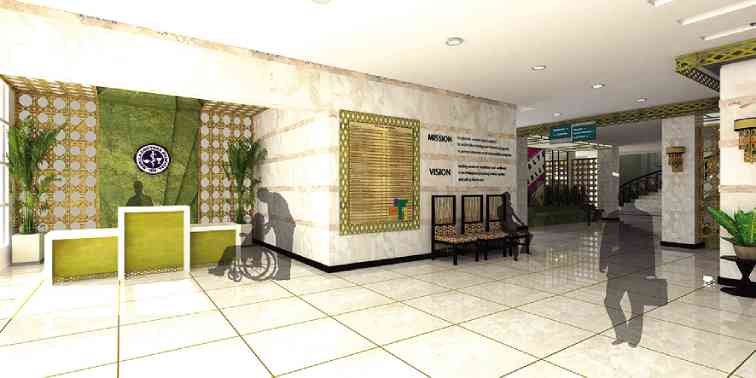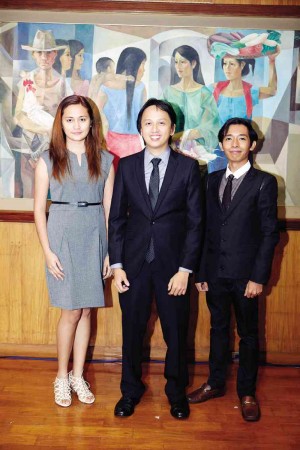

The architecture category of this year’s Metrobank Art and Design Excellence (MADE) contest called for entries to design a waterfront across the iconic Cultural Center of the Philippines. It would serve as port terminal for tourists, foreign and local.
The structure sought to foster the social and cultural needs of tourists while providing a catalyst for economic growth through tourism.
The structure should also use environment-friendly building technologies that would transcend location, time and climactic phenomena.
All these requirements were met by the winning entry, “Agos,” by young architects Jason Romeo Abustan, Anne Lorraine Caban and Jonathan Sadorra.
The design of the main structure exudes fluidity and movement through the use of wavy lines and angles visible not only in the roofing but also integrated in the whole building.
The port’s chief building materials are limestone and concrete, complementing the façade of the CCP, designed by National Artist Leandro Locsin and notable for the sheen of its massive façade, which resulted from the mixture of crushed seashells in the concrete.
The vehicular drop-off, like the CCP’s famous ramp, is an elevated ramp with a water feature as focal point.
“Most architects want to create their own visual or design brand, but for me the most important thing is to create a design for the Filipino people, a design which will suit the needs of our climate, cultural practices and our society,” Abustan said.
Utilizing the concept of waves and the movement of water is not just for aesthetic purposes but also for sustainability: The wavy roofing for open spaces such as Bulwagan ng Sining is angled specifically to provide skylight for natural lighting and to harvest solar energy.
The green roof also functions as a rainwater-collection system. The water stored can be used for landscape maintenance and toilet plumbing.

The wavy form of the walls, roofing and operable transom windows provides better aerodynamics on the coastline and enhances ventilation and natural lighting.
Sustainable materials
Other sustainable materials used in the design are recycled denim or cellulose insulation and glass materials for better heating, ventilating and cooling efficiency, and nontoxic, low-volatile organic compounds for glues and paints.
Agos also provides passengers a breathtaking view of the Philippines through a scenic monorail, which enables people to move around the port.
“As a Filipino architect, our design should promote our nation’s history and cultural heritage, as we are developing the Filipino architecture of the present while also looking forward to future possibilities in the international architecture design scene,” Abustan said.
Abustan and Caban are alumni of University of Santo Tomas. Sandorra graduated from Mapua Institute of Technology.
The jury was chaired by Philippine Daily Inquirer columnist Augusto Villalon. Members were Omar Maxwell Espina, former dean of the College of Architecture and Fine Arts of University of San Carlos in Cebu; former BluPrint editor Paulo Alcazaren; José Danilo Silvestre, former dean of the College of Architecture of University of the Philippines-Diliman; Fidel Siapno, former dean of the College of Architecture and Fine Arts of Aquinas University in Legazpi City, Albay; and CCP asset-development program director Nestor Jardin.
Three Rs of design
For the Interior Design category, the challenge was to design the lobbies of the Manila Doctor’s Hospital on TM Kalaw St. and UN Avenue, Ermita, Manila.
Design entry must reflect the high standard of international medical care while also reflecting Filipino culture.
The winning entry is “Habi,” by Anne Astrid Sangil. It was inspired by the Filipino indigenous tradition of weaving. Her idea was to weave the elements of what make the country an attractive destination for medical tourism: its people, natural resources and climate.
“The Manila Doctors Hospital can serve as a preview for foreigners on the good things they can expect during their stay in the Philippines,” Sangil said.
Sangil’s mantras in conceptualizing the lobbies are the three Rs of design: respect, reuse and reduce. She said hospital spaces should respect the rules of accessibility to ensure that physically challenged people would still have a comfortable hospital experience.
Sangil also designed an environment which allowed the space users to better navigate the area without needing much assistance from the hospital staff.
“The spaces should be able to accommodate different kinds of space users,” she explained.
Decreasing waste
Meanwhile, reuse of materials would decrease waste in construction materials and result in cheaper construction cost as well.
Finally, reduction in energy consumption would be achieved through the use of LED lights, perforated panels and mirrors, which would allow natural and artificial lights to pass through the various areas within the space.
Sangil’s entry utilized perforated panels, multilevel counters, and woven-textile elements in the spatial organization and way-finding signages.
Sangil finished Interior Design at University of the Philippines-Diliman and placed sixth in the board exams.
The jury for Interior Design was headed by Dan Lichauco, principal architect of Archion Architects, which designed the Medical City and Ateneo de Naga Hospital. He is also a faculty member of the UST College of Architecture.
Members of the jury were Rogelio Caringal, Kathryn Abaño, and interior designers Jie Pambid and Antonio Adriano.
Sangil, Abustan, Caban and Sadorra and other winners will be honored during the MADE awarding ceremonies on Sept. 19, 5:30 p.m., at Le Pavillon, Pasay City.











































